Serum by Xfer Records is the most powerful and versatile wavetable synthesizer in the game, no two ways about it.
It can transform simple waveforms into epic, complex sounds and offers unmatched modulation capabilities 一 helping you take your sound design to the next level.
Plus, it offers realtime wavetable manipulation and lets you customize every sound with precise control.
This way, you can build sounds that reflect your unique style/vibe.
As producers and sound designers looking to master the art of Xfer Serum VST, we’re breaking it all down, covering:
- Everything about Serum’s interface ✓
- Oscillator section breakdown ✓
- Sub oscillator & noise oscillator ✓
- Wavetable editor essentials ✓
- Creating and importing custom wavetables ✓
- Advanced modulation sources ✓
- Macro controls for great sounds ✓
- Modulation matrix tips ✓
- Effects rack power ✓
- Wave shapes/filter shapes ✓
- Global settings overview ✓
- Sound design techniques ✓
- OSC/FX/matrix/global settings, etc. ✓
- Much more about why it dominates over other soft synths ✓
By the end of this article, you’ll know absolutely everything about Xfer Serum VST, so you can push your sound design skills to the limits (and beyond).
You’ll be able to knock out original sounds, layer complex patches, and manipulate waveforms with ease.
Plus, you’ll always have fresh, professional-quality sounds at all ready.
Your tracks will not only stand out in any mix but also show off sound design/advanced music production skills that seriously dominate the competition.
NOTE: And don’t think you need to fork out the full list price to use this top-of-its-class, world-famous synth. There are rent-to-own plans available for under $10 a month.
Table of Contents
- Wavetable Synthesis in Serum
- Dual Main Oscillators (OSC A and OSC B)
- Noise Oscillator
- Unison Settings and Detuning Options
- Wavetable Editor
- Modulation Sources
- Modulation Matrix
- Filter Section
- Effects Rack
- Global Settings
- Advanced Features: Summing it Up
- Using an LFO as an Arp/Step Sequencer (My Favorite Trick)
- Bonus: Serum FX
- Final Thoughts
Wavetable Synthesis in Serum
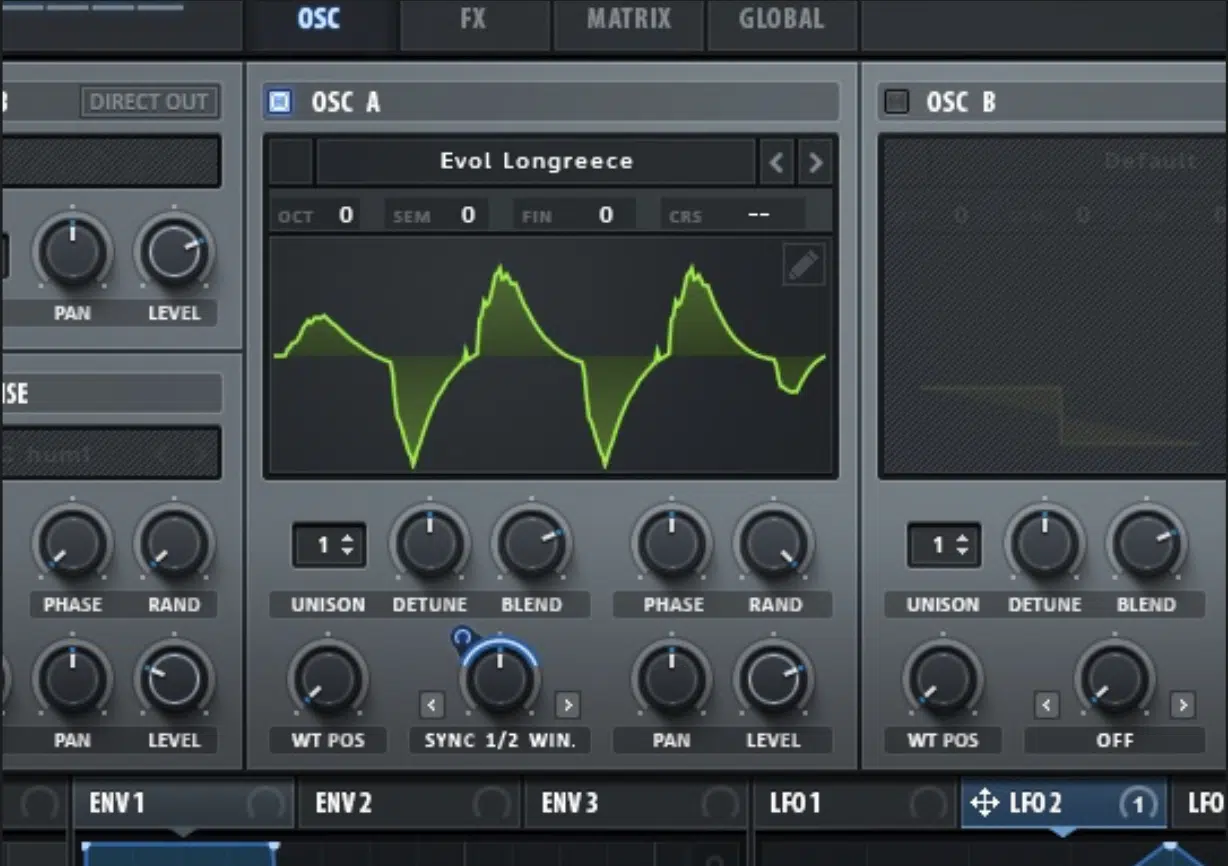
The real magic of Serum VST is in its wavetable synthesis engine, which gives us the power to make custom, evolving sounds by morphing between different wavetables.
Unlike some other synths that lock you into basic shapes, Serum’s wavetable oscillators let us create, modify, or even animate our own wavetables (which I’ll break down later).
This way, every sound can be unique and show-stopping.
For example, I’ll sometimes start with a basic sine or saw waveform and gradually morph it into something more complex, like:
- Adding subtle grit for a lead.
- A slowly shifting harmonics in a pad for extra depth.
- Knocking out evolving bass sounds with rhythmic movement.
Serum’s wavetable editor is where this really shines, which is why it’s one of the most famous in the entire music industry.
You can draw in your own waveform, load up audio files, or even drop in a vocal snippet to convert into a wavetable oscillator.
And if you’re like me and love getting really specific, the wavetable synthesis here has warp modes, like FM, AM, and RM, for more textured, unique sound design.
Serum isn’t just about providing you with a collection of sounds…
It’s about giving you the freedom to sculpt your own masterpieces, which is huge for EDM genres and other genres where originality matters most.
Dual Main Oscillators (OSC A and OSC B)
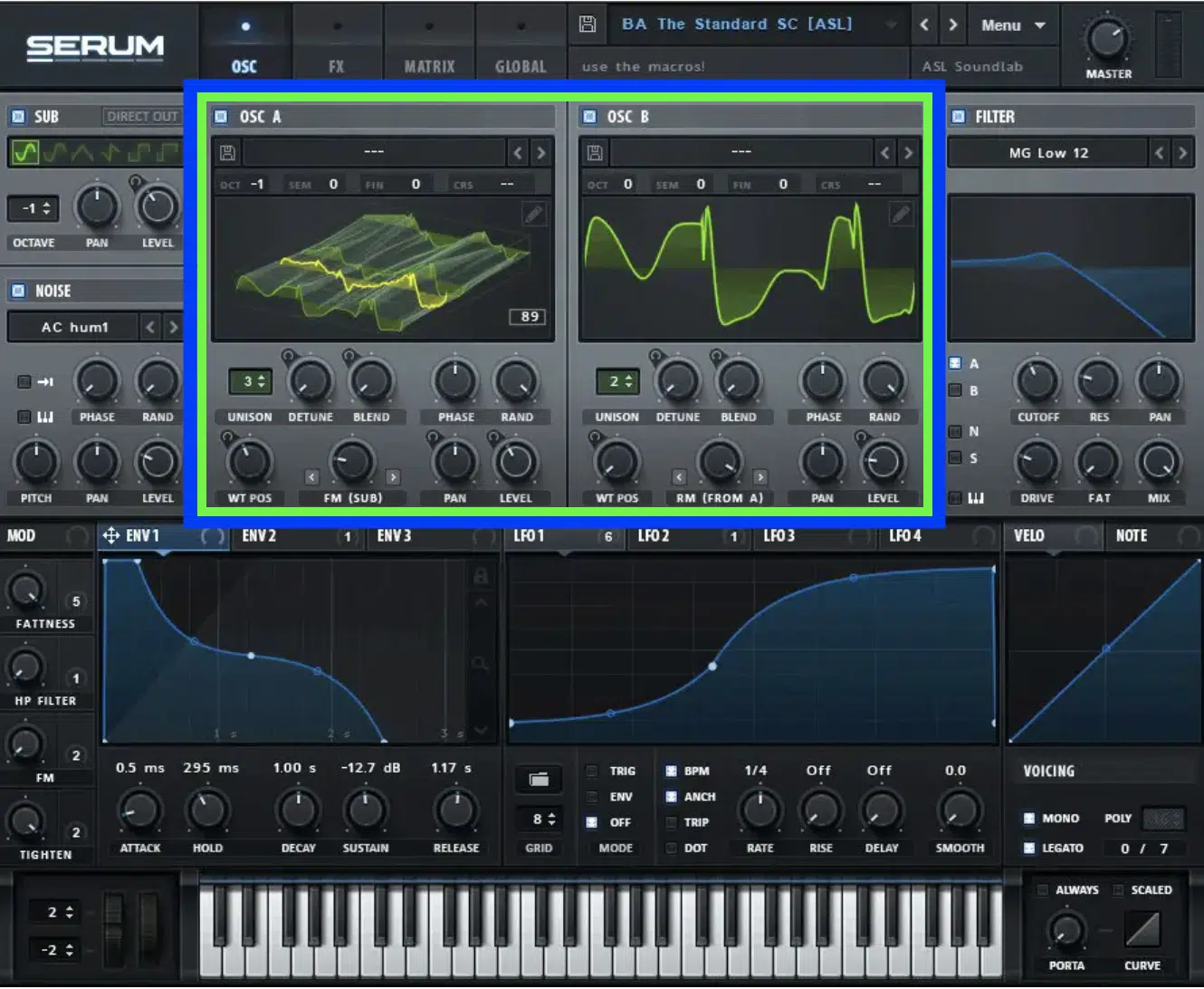
The heart of Serum’s oscillator section lies in its dual wavetable oscillator with the multi-configurable OSC A and B, which give you an incredible range of flexibility.
Each oscillator allows us to load different wavetables, so you can mix a clean sine wave on OSC A with something dirtier, like a metallic wavetable, on OSC B.
This combo can add extra harmonics and dimension to your sound, making it easy to create anything from bass-heavy growls to smooth, airy leads.
I love using OSC A for the main tone using a more basic wave and keeping OSC B for subtle enhancements, but it’s dealer’s choice.
Sometimes setting it an octave higher or using it to add grit with unique waveform shapes (it’s all about getting creative).
Each wavetable oscillator has warp modes like FM, RM, and Sync, so you can apply advanced cross-modulation between OSC A & B.
This, of course, will give your sound some extra movement and a dynamic edge.
For example, setting OSC A with a standard wavetable and adding FM modulation on OSC B can give you a metallic, almost industrial edge.
This is a go-to trick for genres like Future Bass and other electronic music.
And since Serum is a wavetable synth, both OSC A and B have incredibly clean sound quality, so every little harmonic detail stands out.
Overall, these dual wavetable oscillators open up so many creative options and make Serum sound better than other synths I’ve tried… ever.
-
Pro Tip: Sub Oscillator Functionalities
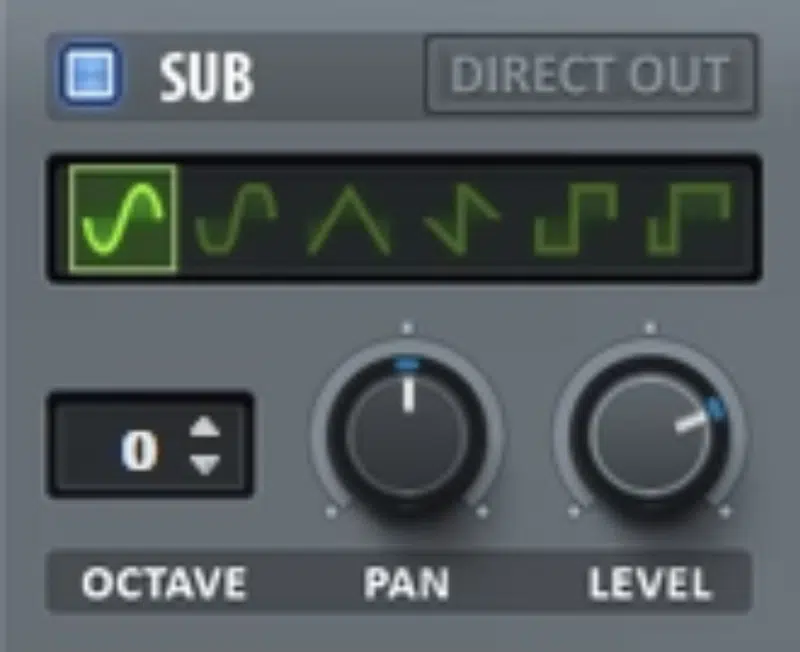
Serum’s sub oscillator might seem simple, but its sound design potential is anything but, as it’s a powerful way to beef up your sound without crowding the low end.
Positioned separately from the main wavetable oscillators, the sub oscillator is dedicated to generating clean, low-frequency tones.
It’s perfect for adding a solid bass foundation.
Also, it can be used as a utility for purposes beyond functioning as a sub-oscillator, as its pitch can be set in a positive range as well.
Noise Oscillator

The noise oscillator in Serum VST brings a whole other layer of texture and depth to the table, which you can really go crazy with.
Unlike other synths where noise can feel limited, Serum’s noise oscillator gives you access to an entire library of noise samples, think:
- Vinyl crackles
- Crowd noises
- Various organic textures
All of which can successfully be pitched and looped all day long.
This is super useful for sound design/advanced music production where you want to give your patches more presence or a more analog, organic feel.
Like when you want to add atmosphere to electronic music, stuff like that.
For example, adding a light vinyl crackle to a pad can bring warmth, while a harsher white noise layer can make your lead sound punchier and more aggressive.
The noise oscillator isn’t just for static noise either 一 you can apply modulation to it, setting up movement that syncs with the rhythm of your track.
In fact, I tend to call it the “Sample Osc,” as you can load just about any sample you want.
For example, this allows you to create something like a brass patch with OSC A and B, while using the Noise Osc to layer it with a real brass one-shot.
The noise oscillator is definitely one of those underrated (often misunderstood) elements that can elevate your sound in ways that go far beyond traditional noise.
Unison Settings and Detuning Options
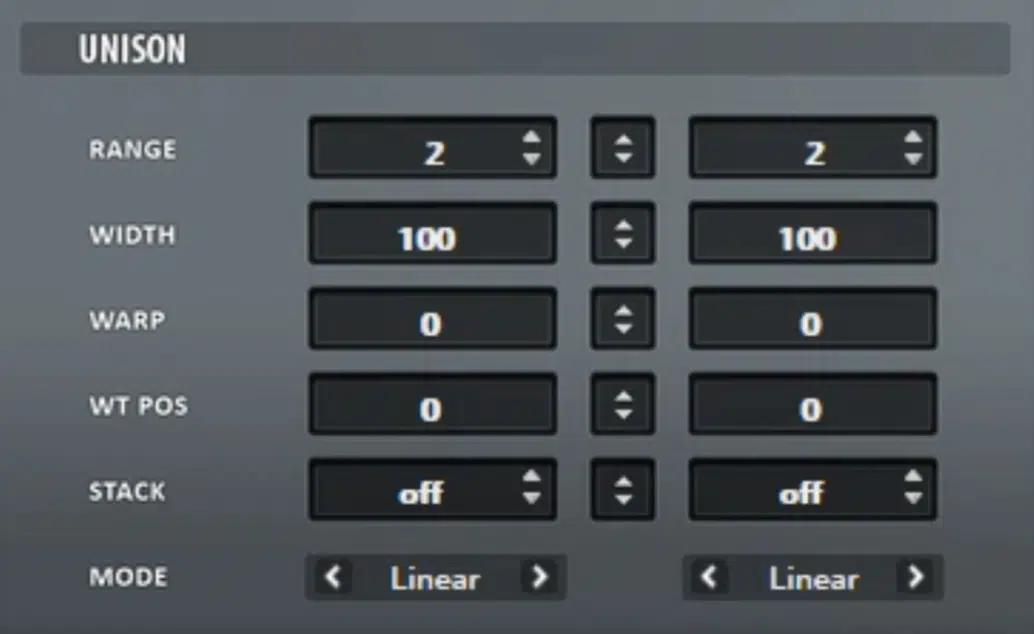
One of the other features that makes Serum VST so versatile is its Unison settings, which lets you create super thick sounds by layering multiple voices.
With Unison, you can turn a simple waveform into something massive… Think of it like stacking the sound on top of itself multiple times.
For example, setting your dual wavetable oscillators to 7 or 8 voices can give you that classic, wide lead supersaw sound you hear all the time in electronic music.
You can simply select a saw wave on OSC A, and for OSC B, you could play around with a different waveform like a square or even something more textured.
Then, adjust the attack and release in the envelope settings to smooth out the transitions 一 giving it that dreamy swell.
Keep in mind that adding a gentle low-pass filter can help tame any harshness, especially if you’re working with high resonance.
NOTE: Since the Unison functionality can be enabled independently on OSC A and B, I usually set one single oscillator to a higher Unison with mild detuning (somewhere around 0.1 to 0.2) and keep the second oscillator cleaner with fewer voices (~2-4).
Modulating the detune settings slightly with a slow LFO also adds beautiful analog movement in the stereo field.
To do so, simply assign the LFO to the detune parameter and set the rate to something subtle, like 0.1 Hz.
This balance makes for an impactful, layered sound that’s both wide and focused.
Wavetable Editor
Serum’s wavetable editor is where the creativity really kicks in. You can completely control your wavetable synthesis from start to finish. From laying down custom wavetables from scratch to bringing in virtually any existing audio for some truly original sound design, you can accomplish it all.
-
Creating and Importing Custom Wavetables
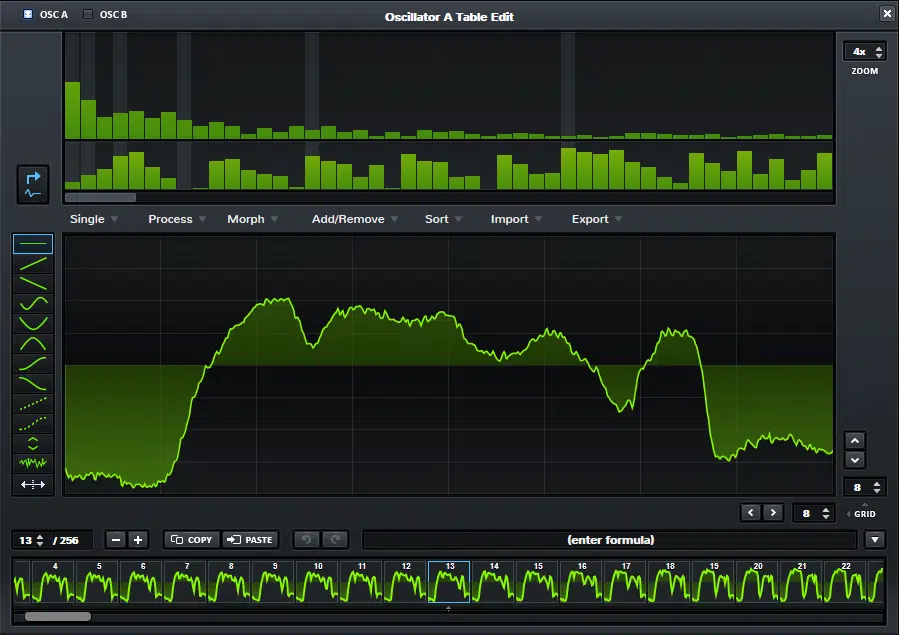
In the wavetable editor, Serum VST gives you the freedom to bring in audio files and convert them into playable wavetables.
When it comes to sound design, this is honestly a game-changer.
You can drag in a vocal sample, a drum hit, or even ambient noise Serum analyzes the sound 一 breaking it down into a wavetable that you can play across the keyboard.
You can also save the wavetable and use it in any other wavetable synth that allows custom imports, so that’s impressive as well.
Personally, I like to design custom wavetables for all my sound design work to add/ensure an extra layer of originality (which sounds amazing).
Side note, if you want to learn how to become a sound designer, we got you.
For example, I once imported a bird chirp and used it to add an airy, organic texture to a pad sound… Talk about unique.
I also like to blend custom wavetables with Serum’s preset shapes to create a mix that keeps some familiar tones while introducing unexpected textures.
-
Drawing and Editing Waveforms
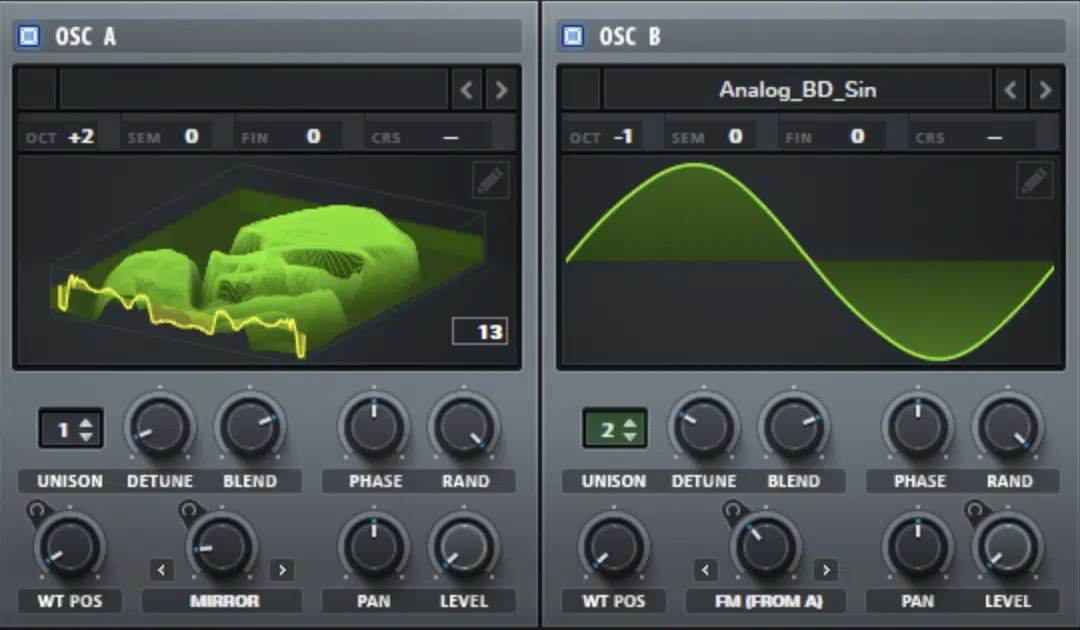
For producers who want total control over each wave cycle (which you definitely should), Serum’s wavetable editor allows you to literally draw your own waveforms.
This feature is perfect for those moments when you want to create something truly original, as it gives you complete control over every peak, valley, and curve of the sound.
I’ve found that drawing in extremely small deviations to just a section of a basic sine wave so it’s not perfectly curved and round, can add awesome (and subtle) harmonics.
It gives the sound a more complex texture that stands out in a mix.
This technique is great for creating bass patches, especially 808s, as it allows you to impart some dirt and grit to the 808 at the source before even applying saturation.
Trust me, they’re not mutually exclusive, and using both results in a distinctly different sound, so make sure to experiment.
Serum also includes mathematical functions that let you enter your very own formulas to generate waveforms, which is amazing if you’re looking to create perfectly tuned harmonic series or experimental sounds.
For example, I’ll sometimes use a simple sine-to-square morph to add bite to a bass patch or a soft curve to smooth out a lead.
Once you’re happy with your custom waveform, you can save it for future use 一 making Serum VST not just a synth, but a personal sound library.
Whether you’re creating lead sounds, pads, or basses, drawing in these unique shapes is a game-changer for your sound design game.
Modulation Sources
One of the things that sets Xfer Serum VST apart from any other wavetable synthesizer is its flexible, intuitive modulation system. It offers endless possibilities for shaping sound. So, let’s explore each of the drag-and-drop modulation sources available, starting with the most essential tools for movement: envelopes and LFOs.
-
Envelopes: ADSR Controls and Applications
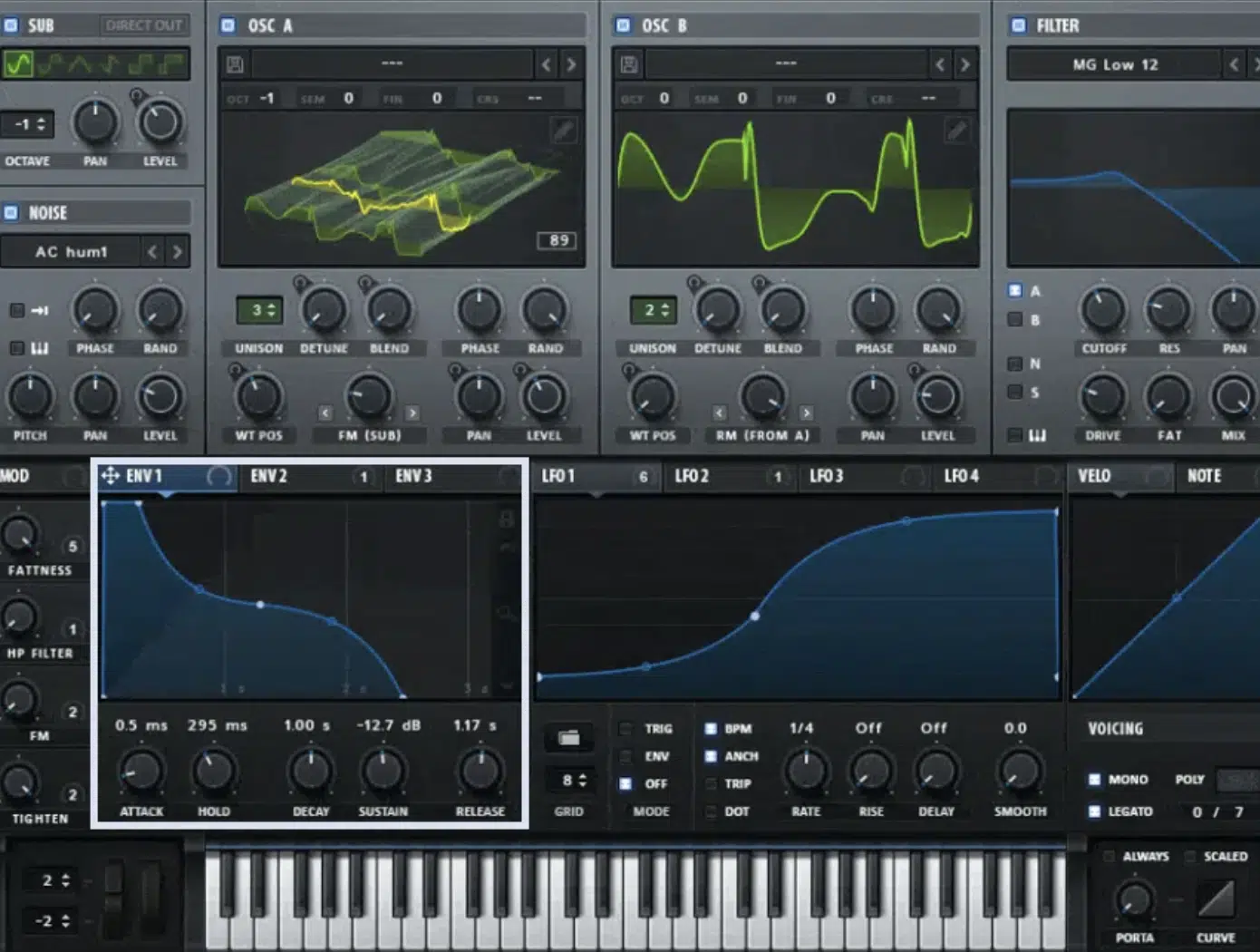
In Serum, ADSR envelopes (Attack, Decay, Sustain, Release) are key for shaping how a sound unfolds over time, and Xfer Serum VST gives you endless control over these parameters.
Each envelope can be assigned to different aspects of your sound, such as:
- Volume
- Filter cutoff
- Pitch
It lets you add precise articulation to any patch, anywhere, anytime.
For example, setting a slow attack and long release on a pad sound creates a gradual, swelling effect 一 perfect for ambient and electronic music.
On the other hand, if you’re designing a punchy bass, you might want a sharp attack with a short decay so the sound hits hard but fades quickly (ideal for bass music).
Serum VST also lets you tweak the curve of each segment of the envelope, so you can get super detailed by adjusting how abruptly/smoothly each stage progresses.
One feature I find sick is the ability to modulate multiple parameters with a single envelope…
Say, applying it to both the filter cutoff and the oscillator section for fluid, cohesive movement across the sound (pretty cool, right?).
This flexibility, paired with Serum’s clear visual feedback, lets you fine-tune the envelopes in real-time.
This way, you’ll always know exactly how your changes are affecting the final sound.
NOTE: Just about every parameter in Serum is ‘modulatable,’ so to speak. Yes, including ones you might not expect or don’t have direct access to on the main interface.
They can be found in the Mod Matrix’s dropdown menu for the source, destination, and/or the sidechain.
-
Low-Frequency Oscillators (LFOs): Shapes and Rates
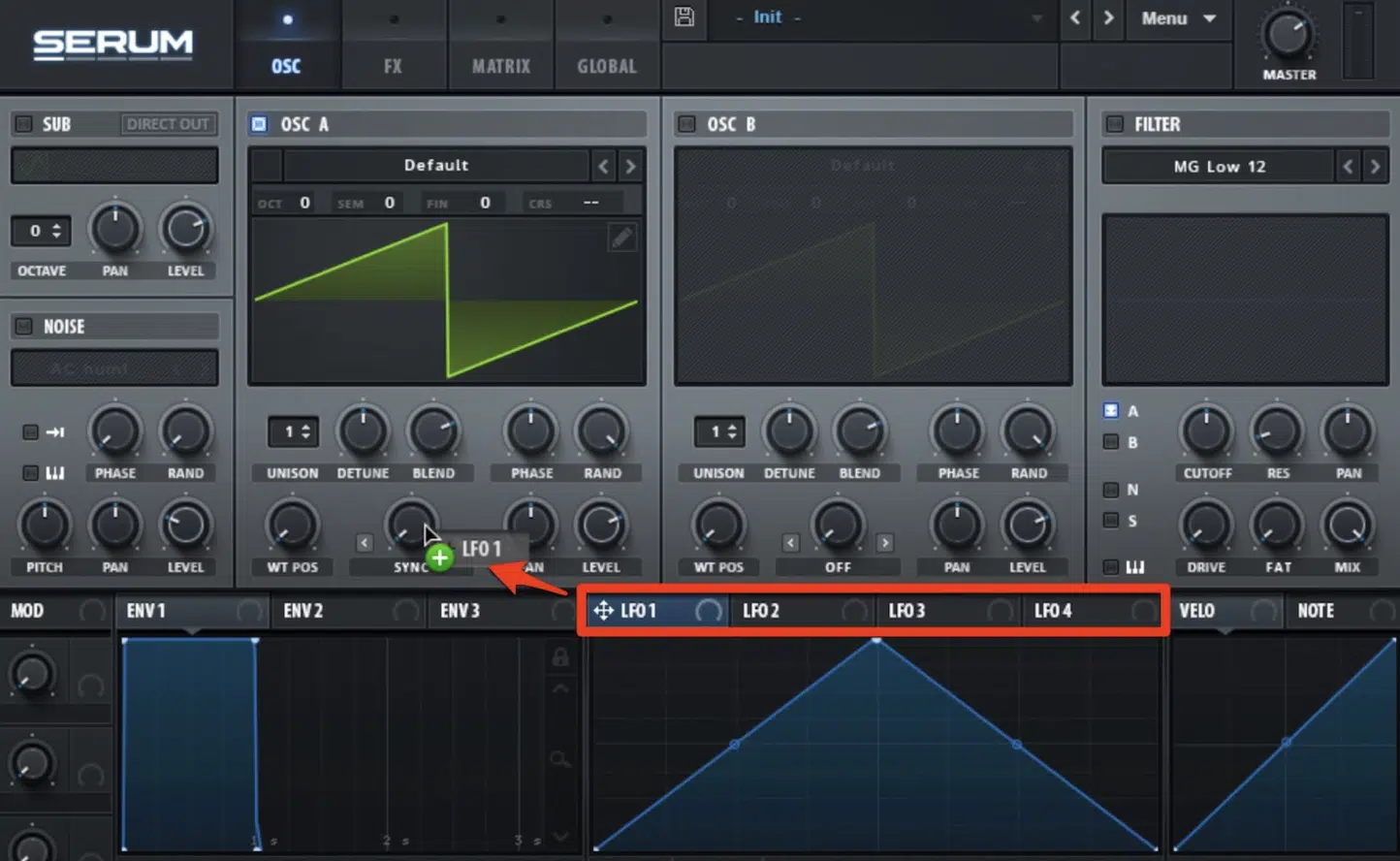
The Low-Frequency Oscillators (LFOs) in Xfer Serum VST are key to injecting movement and rhythm into your sounds with a wide range of shapes and rates.
Plus, few (if any) other software synths can bear the flexibility of the LFOs.
I know I touched on that before, but I thought they certainly deserved their very own section because they are vital.
Each LFO in Serum VST can take on various waveform shapes for unique modulation styles that can turn any static sound into something much more alive.
This includes sine, triangle, square, and even custom-drawn shapes.
For example, I like to use a slow sine wave LFO on filter cutoff to create that classic, sweeping effect for pads or atmospheric sounds (a go-to in electronic music).
Xfer Serum VST also allows you to set precise rates for the LFOs, which can sync with your DAW tempo, perfect for rhythmically aligned movements in genres like Future Bass.
You can set the rate as slow as one cycle every few bars for subtle effects or crank it up for fast, rapid modulation that adds urgency to leads or percussion.
One of my favorite features is the ability to change the LFO shape (along with any of its parameters) mid-sound 一 letting it morph between shapes.
This is a trick that adds complexity and keeps sounds evolving in real-time.
And with the visual representation in Xfer Serum, you can see exactly how each LFO shape changes and interacts with your parameters.
So, it’s much easier to dial in exactly what you’re aiming for.
-
Macro Controls for Real-Time Parameter Adjustments
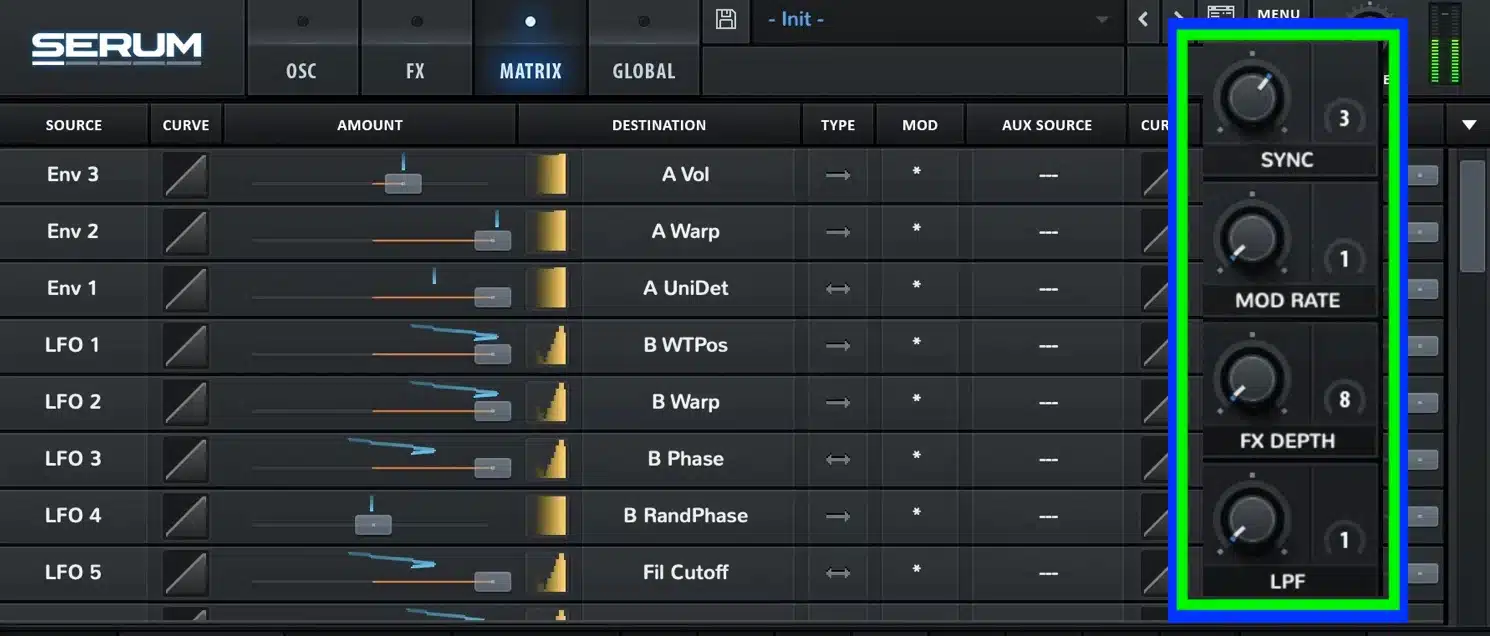
Xfer Serum VST’s Macro controls are super important for live tweaking and very intricate real-time sound adjustments.
It gives you the power to control multiple parameters at once with just a single knob.
Let’s say you needed to change the filter cutoff, reverb mix, and detune all at the same time… By using macros, you can assign a few controls to a single knob.
It really streamlines your entire creative workflow.
For example, when designing a complex patch, I usually set up one Macro to control the brightness of the overall sound by linking it to both the:
- Filter cutoff.
- High-end EQ settings.
This way, I can adjust the tone from mellow to bright with one easy move.
Each Macro can also be automated in your DAW, which is very useful for adding movement over time (think gradually increasing intensity in a drop).
Another great application is for live performances, where you might want to adjust multiple aspects of a sound instantly without messing around with individual settings.
Personally, I’ll often dedicate one Macro to adjust an LFO rate 一 allowing me to control the rhythm of a wobble bass on the fly.
If this type of altering sounds fun to you, you’ve definitely gotta check it out.
Thanks to the flexibility of Xfer Serum’s Macro system, you can create highly interactive sounds that adapt to your music in real-time.
When compared to many other synths/software synths, this is a standout feature that really makes it the best in the world (at this time).
Modulation Matrix
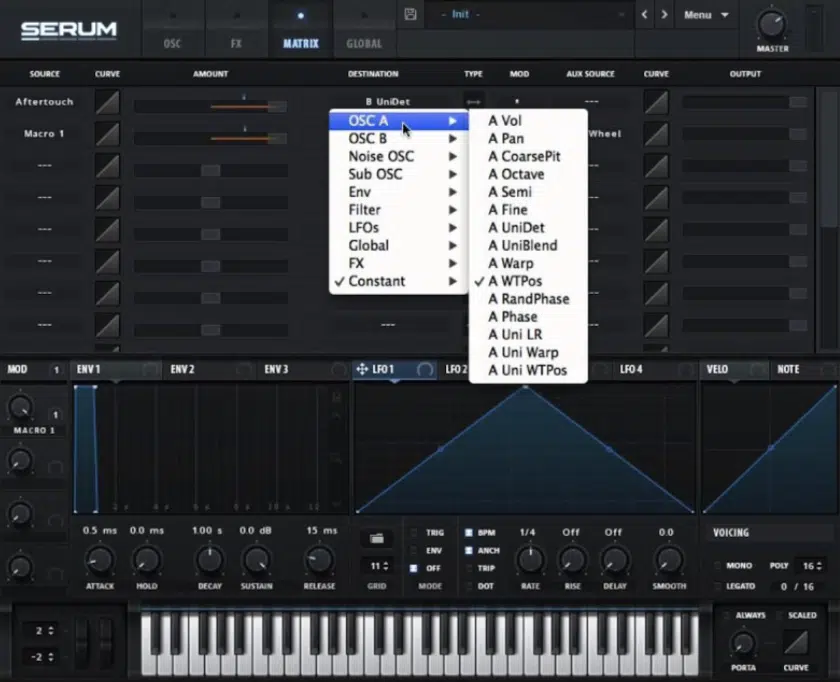
Ahh, Serum’s MOD Matrix… where the real depth of this synth comes into play.
The Modulation Matrix in Xfer Serum VST gives you complete control over how different modulation sources interact with various parameters.
It acts as a central hub where you can connect any modulation source (like envelopes, LFOs, or Macros) to almost any parameter, from wavetable oscillators to effects.
For example, if you want an LFO to control both the pitch and filter cutoff, the MOD Matrix makes it easy to route these connections and adjust their intensity.
To do this, simply select your LFO as the source and route it to both the:
- Oscillator pitch (set the amount to around 5-10)
- Filter cutoff (try a higher intensity here, around 20-30)
This will create a sweeping effect that’s rhythmic and dynamic (and mind-blowing).
By adjusting the LFO rate to something slow, like 0.2 Hz, you get a subtle, evolving shift that adds character without overpowering the sound.
One thing I find dope is the ability to see the visual representation of each modulation link 一 making it intuitive to add modulations that are super complex.
All without getting lost or insanely frustrated, which keeps you in the creative zone.
You can even use multiple modulation sources on a single parameter for nuanced control over sound evolution.
I love stacking an envelope and LFO on the same parameter to create a high-quality sound that has both a sharp attack and a gentle, rhythmic movement.
For instance, try stacking an envelope and LFO on the same filter cutoff…
Set the envelope to shape the initial attack and decay (try an attack of 0.1 seconds and decay around 0.5 seconds) and assign the LFO.
This combination creates a sound that hits sharply at first and then shifts gradually 一 giving it both punch and flow (and I highly recommend you try that out).
NOTE: This feature, combined with Serum’s simple drag-and-drop, creative, workflow-oriented interface for quickly assigning modulations, gives you total freedom to experiment with highly interactive, animated sounds that stand out in any genre of electronic music.
Filter Section

Xfer Serum VST’s filter section is powerful, versatile, and loaded with options as I mentioned earlier.
It offers a range of filter types that allow you to shape and refine your sound.
From classic low-pass and high-pass filters to more unique filter types, like:
- Comb filters
- Formant filters
- Scream filter (the recent addition)
Serum’s filter selection lets you fine-tune the tone, depth, and character of your patches.
I frequently use the low-pass filter with a gentle slope on leads, which gives them a smooth, rounded sound (very professional and clean).
One the flip side, a sharper high-pass filter can clean up bass patches 一 leaving just the punchy low end.
Xfer Serum even allows you to route different parts of your sound (all 4 OSC types) through the filter independently.
This is especially handy for adding character to the noise oscillator without affecting the main oscillators, which you don’t want.
Or, as I prefer, the other way around.
Another standout feature here is the cutoff knob, which is highly responsive and perfect for creating those sweeping filter effects with precision.
You can also modulate the filter cutoff with an LFO, envelope, Macro or any other of its long list of MOD sources as I said.
It lets you create dynamic filter movements that evolve with your track.
This filter section is a major part of what makes Serum so versatile and gives you the ability to shape your sound exactly how you need it; easy peasy.
Effects Rack
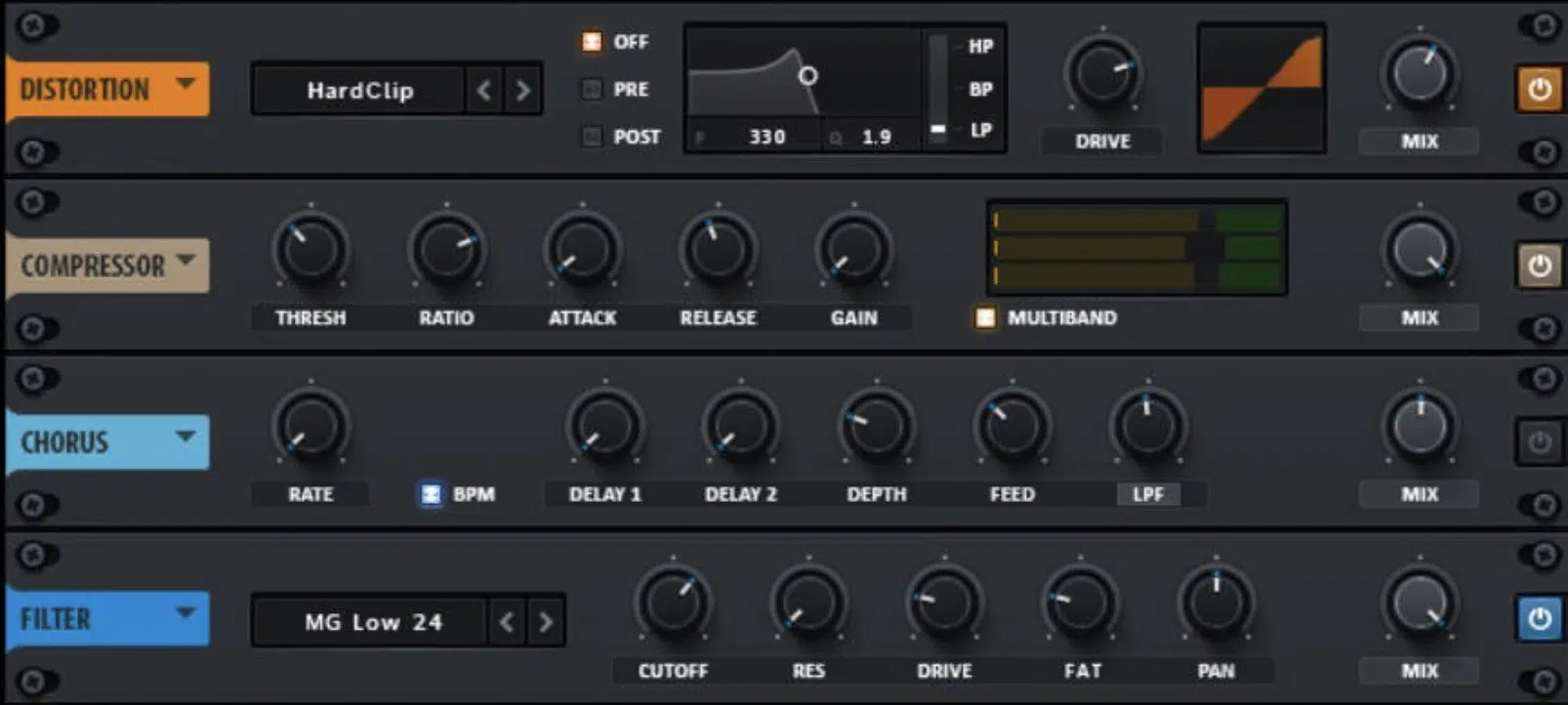
The Effects Rack in Xfer Serum VST is packed with a range of built-in effects that take music production/sound design to another level.
You’ll be able to add depth, color, and punch to any patch.
This rack includes essentials like reverb, delay, distortion, and chorus, as well as more specialized effects such as flanger and phaser (each one is highly customizable).
And, even an updated version of the original Xfer OTT multiband compressor, which you can learn all about in our OTT article.
What’s unique about Xfer Serum is that you can reorder effects in the signal chain (simply drag them around).
So if you want distortion to hit before reverb or EQ, you can easily make that switch.
I typically place the EQ after the distortion to carve out any harsh frequencies, which keeps the high-quality sound clean yet powerful.
Serum VST also lets you modulate nearly every parameter within the Effects Rack of course, which is perfect for adding movement.
For example, you can assign an LFO to control the wet/dry mix of the reverb 一 creating a dynamic effect that blends in and out, adding space to a sound without drowning it.
This level of control in Xfer Serum VST’s FX section really helps sounds stand out in a mix, especially in electronic music where unique textures are key.
The Effects Rack is one of those features that makes Serum by Xfer Records so much more than just a standard synth.
Global Settings
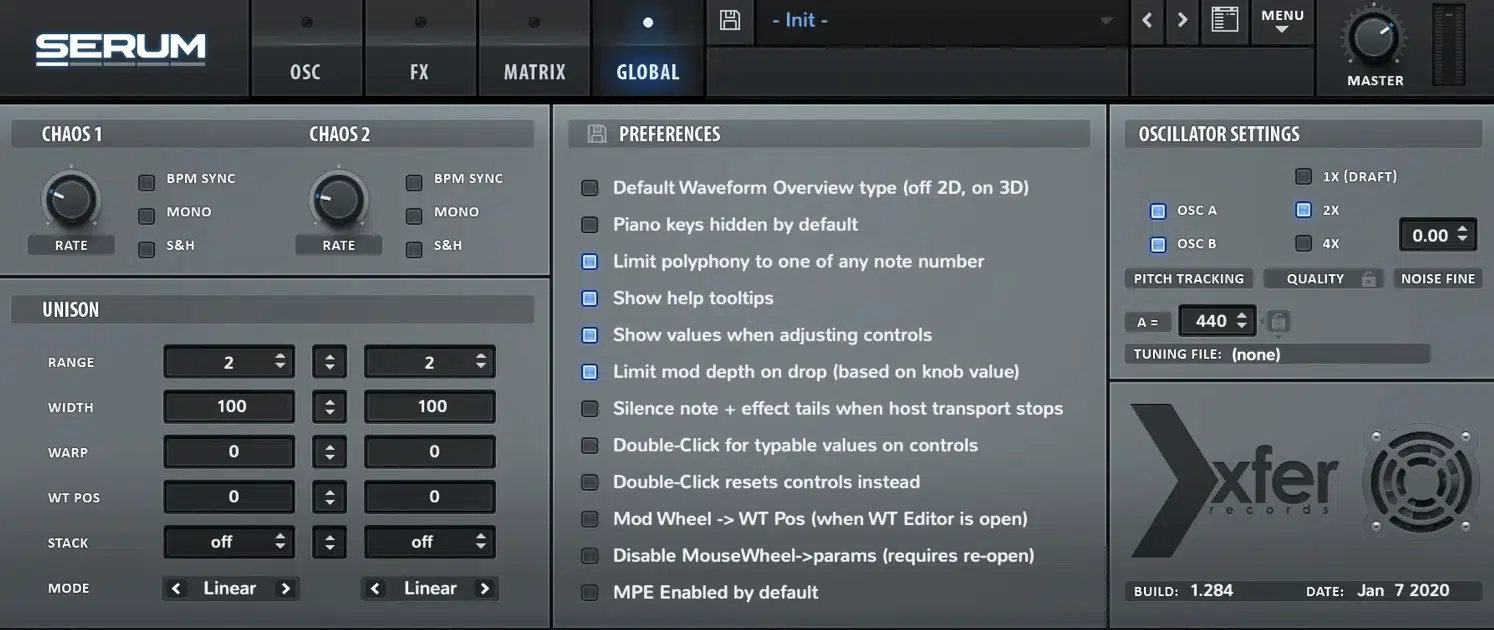
The Global Settings in Xfer Serum VST provide essential control over how Serum behaves across all patches, offering options like:
- Polyphony 一 Controls the maximum number of notes Serum can play.
- Oscillator quality 一 Adjusts the resolution of the oscillators.
- Pitch bend range 一 Sets the pitch bend range for MIDI controllers.
For example, if you want to keep Serum’s CPU usage low, you can adjust the oscillator quality settings to a lower resolution when designing sounds.
Then, increase the quality when it’s time to bounce, which is perfect for managing resources in large projects.
The Global tab also lets you set the pitch bend range, which is useful for setting up expressive leads or basses that benefit from subtle or major pitch changes.
I like to set this up or down in multiples of 12 semitones to enable quick pitch jumps and dives, making it effortless to automate an 808 slide (even in real time).
You can also configure polyphony to limit the number of voices used, especially if it’s a crazy amount 一 helping reduce CPU load without sacrificing overall sound quality.
Serum’s Global Settings are streamlined yet powerful, which gives you complete control over how Serum operates across different sounds/environments.
Advanced Features: Summing it Up
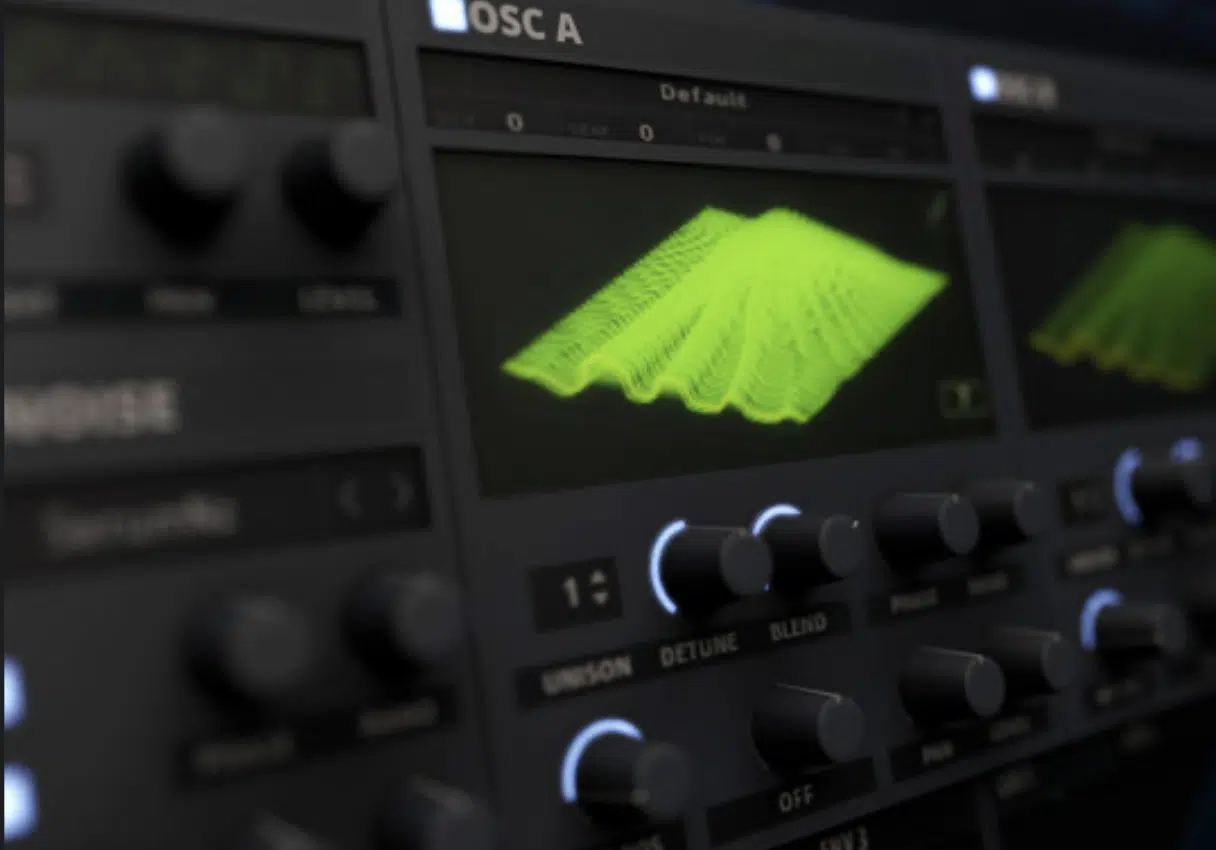
Xfer Serum VST stands out as a soft synth due to its impressive variety of advanced features that make complex sound design/music production accessible and fun.
#1. One of my favorite features is the real-time wavetable visualization, where you can visually see an animation of the wavetable as it’s being modulated.
This is perfect for creating moving, evolving sounds without having to guess how they’ll behave—what you see is truly what you get.
#2. Serum also includes a formula parser, which allows you to input mathematical expressions to create unique waveforms or tweak existing ones like we talked about.
For example, using a formula like “sin(x) + 0.5 * sin(2x)” will add harmonics, which gives you control over the timbre with precision.
Don’t worry, even if you’re not great at crunching numbers or whatever, you’ll be able to play around with this and master it in no time when you learn Serum.
#3. You also get MPE (MIDI Polyphonic Expression) support, ideal for expressive control when using hardware like the ROLI Seaboard.
#4. Plus, Serum has drag-and-drop functionality throughout, so setting up complex modulations or layering effects is smooth and intuitive.
These advanced features, and everything else we covered, make Xfer Serum VST not just powerful but incredibly user-friendly for producers of all levels, period.
This is very important especially when dealing with such a complex topic like advanced sound design.
NOTE: If you want to know everything about reverse-engineering presets in Serum VST, I broke it all down with my own personal, industry secret. Do NOT miss out on this one.
-
Pro Tip: Preset Management
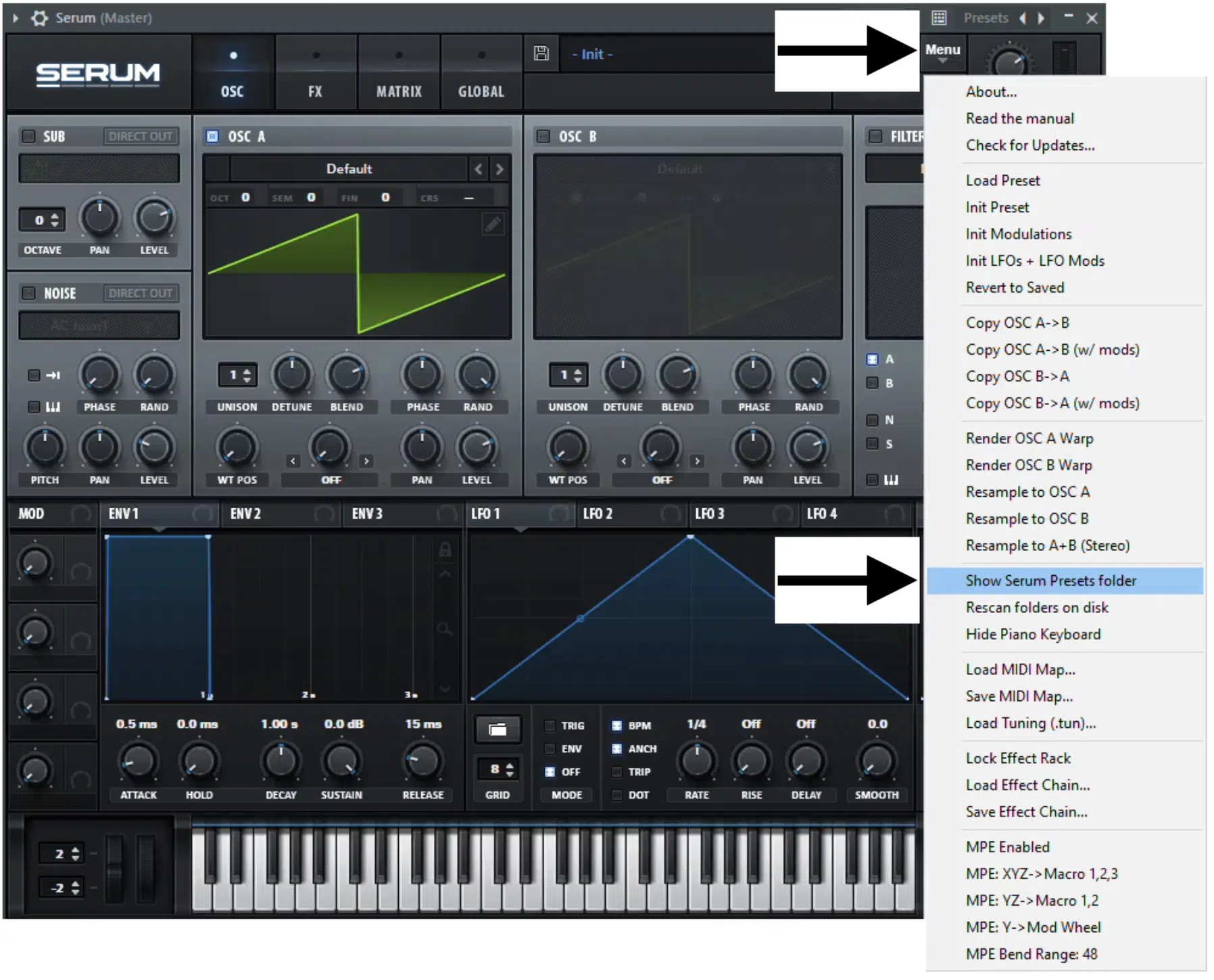
Xfer Serum VST makes it easy to manage, save, and organize presets, which is a huge plus when working on multiple projects or simply exploring new sounds.
Serum’s preset browser is organized into categories, so you can easily find basses, leads, pads, and other high-quality sound types without getting lost in an endless list.
When creating your own presets, you can save them into custom folders and even tag them for easier recall later on.
For example, I keep a folder for Future Bass patches and another for atmospheric pads, which saves a ton of time when I’m in my zone.
NOTE: Serum’s preset system also lets you import FREE Serum presets from the vast community of users.
Meaning, you’ll have access to new sounds and ideas without even opening the wavetable editor (dope, right?).
Side note, if you want to learn all about the best Serum presets or how to easily install Serum presets, we got you covered.
Using an LFO as an Arp/Step Sequencer (My Favorite Trick)
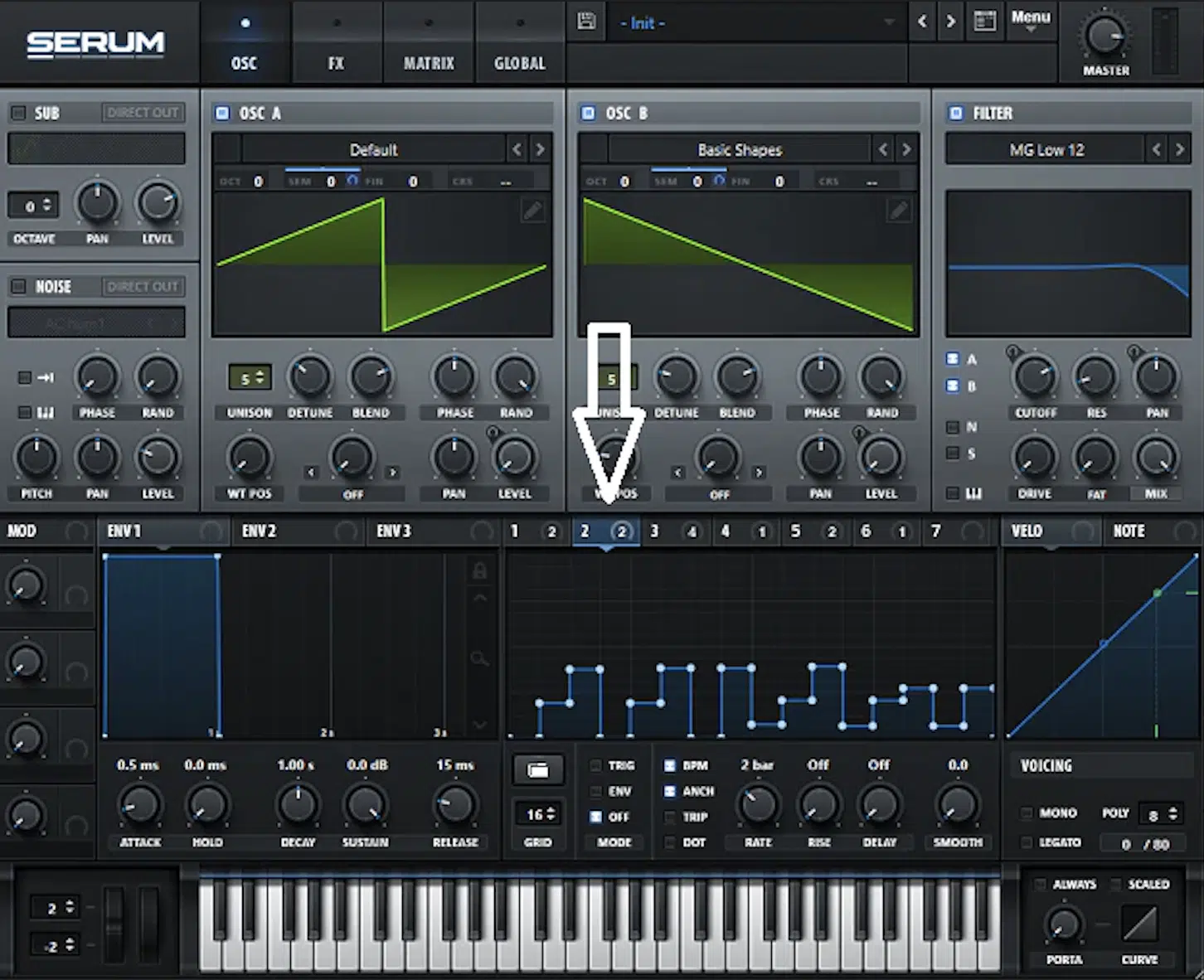
A lesser-known trick in Xfer Serum VST is using an LFO as an arpeggiator or step sequencer, which can turn a simple patch into a rhythmic powerhouse.
To do this, set the LFO to a stepped shape by clicking the desired area while holding shift and sync it to your DAW’s tempo.
Then, assign it to control pitch, filter cutoff, or volume.
By setting each LFO step to a different pitch, you can create sequences or arpeggios that play in sync with your track (which hooks people in right away).
For example, assigning a stepped LFO to pitch can turn a simple sine wave into a pulsing bassline, which is perfect for electronic music or even hip-hop beats.
You can also use the LFO to sequence filter movements 一 creating a choppy, gated effect that adds rhythm without needing an external arpeggiator.
Personally, I like setting the LFO to a rate of 1/8 or 1/16 to lay down fast sequences that lock perfectly into the beat.
Xfer Serum VST’s visual feedback makes it easy to see exactly where each LFO step lands for precise tweaking until you get the perfect rhythm down.
This technique is fantastic for creating innovative, rhythmically driven patches directly in Serum VST without any hassle.
Bonus: Serum FX
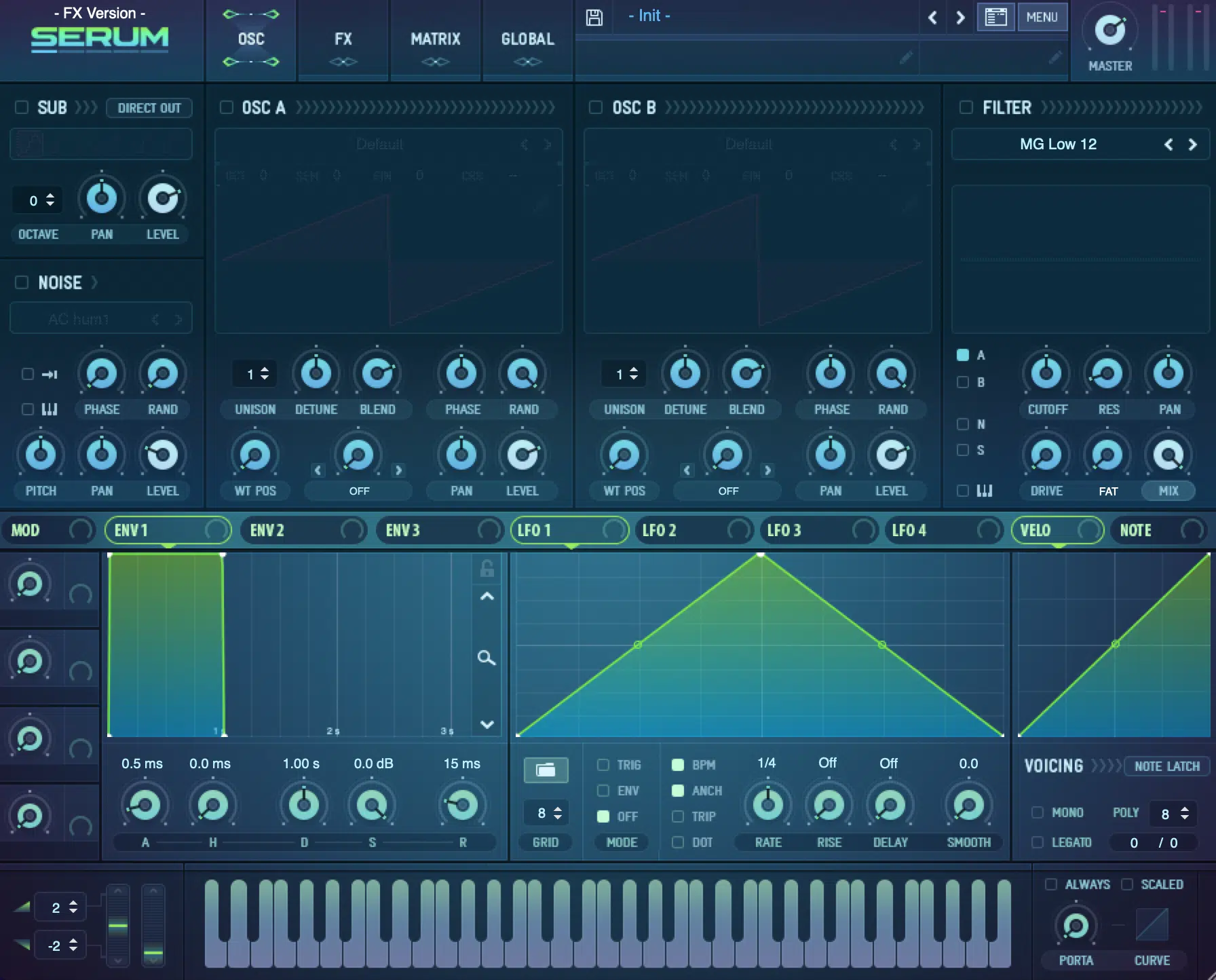
Serum FX brings the entire effects suite from Xfer Serum VST into a standalone plugin that you can apply to any audio track in your DAW.
This setup is incredibly powerful if you want to use Serum’s distinct effects, like distortion types, reverb, and the upgraded OTT multiband compressor, on:
One of the best parts is how Serum FX keeps the drag-and-drop modulation system, so you can assign LFOs or envelopes to effect parameters.
Just like you normally would inside Serum by Xfer Records.
For example, you could modulate the delay time with an LFO to get a rhythmic, evolving echo, or apply a slow-moving envelope to the reverb size to make it expand over time.
Serum FX also lets you get really precise with routing for flexible control over where each effect sits in the signal chain, which is rare in most FX plugins.
Plus, it supports MIDI input, so you can sync modulations to your track’s tempo or even control parameters with your MIDI controller 一 making it awesome for live tweaking.
If you’re looking to add even more depth, character, and rhythmic interest to your tracks, Serum FX gives you the creative freedom to take your sound design/music production to new levels, no doubt about it.
Final Thoughts
Serum VST is, without a doubt, the most powerful and versatile wavetable synthesizer available today.
Its intuitive interface, deep modulation capabilities, and pristine sound quality make it a must-have for any serious music producer.
With it, you can create basses, leads, pads, and unmatched textures that take your beats to new levels you never thought you could reach.
Using the tips, tricks, and techniques we covered today, you’ll never have to worry about limited sound possibilities again.
And, as a special bonus, you’ve got to check out the Free Serum Essentials pack.
This collection includes professional-grade presets in all styles 一 featuring 808s, basses, guitars, keys, leads, pads, and plucks.
Each unique preset is polished and prepped with macros, so it’s super easy to tweak and perfect for creating unique sounds without starting from scratch.
So, now with this guide as your guide (pun intended), you’ll be able to push Xfer Serum VST to its full potential and you might even shock yourself in the process.
I bet after the first few times you use it, it will shortly become your ultimate go-to synth for designing groundbreaking sounds.
Your tracks will not only stand out but will showcase your refined, professional sound design skills, helping you stay ahead in any genre.
Just don’t be afraid to push boundaries, break molds, and get creative with your sound design techniques (nothing is too crazy!).
Until next time…







Leave a Reply
You must belogged in to post a comment.